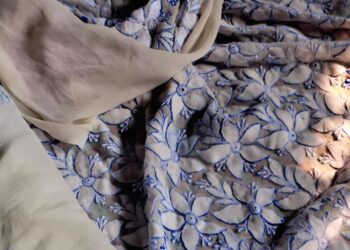No products in the cart.
Sustainable Fashion
“Traditionally, India has always had a penchant for sustainability when it comes to clothes”
In the fashion world, sustainability has come become synonymous with protecting the natural environment while looking good. But is that all there is to practicing fashion ethically?
At its core, fashion needed to be sustainable because of the large amounts of water that was required to produce clothes for fast fashion brands. By definition, fast fashion meant that it may literally leave stores within a week; and this led to the production of enormous amounts of waste that ended up in landfills when numerous brands scurried to produce the latest trend to outdo competitors. The boom in fast fashion is partly due to the increased purchasing power of the middle class in the last decade, according to Nohar Nath. In recent years, however, Instagram influencers have also been particularly instrumental in promoting the latest fashion trends of fast fashion brands by marketing those clothes via social media profiles to their mostly younger audience.
With new emerging knowledge about our changing climate milieu, the market that was dominated by fast fashion is now undergoing a shift and it has become more important than ever to revisit the ways in which popular brands source and make their garments. For example, both H&M and Zara have come out with their respective sustainable clothing lines, proving that you can have your cake and eat it too.
Globally, attention has also shifted towards purchasing pre-loved clothes, or wearing more vintage garments. According to Goodnet.org, fast-fashion retailer Nordstrom is the newest participant in this trend of offering second-hand clothes in its stores. By taking this step Nordstorm has joined retailers such as Macy’s, J.C. Penney and Madewell, who had previously taken a step in a similar direction. This movement of purchasing second-hand clothes has propelled consumers to pay more attention to the craftsmanship of a garment and to its timeless value.
“When I see brands using vegan sources, recyclable materials and natural dyes, I find it in line with what I believe art should do – inform you and at the same time make you think deeply”

Traditionally, India has always had a penchant for sustainability when it comes to clothes. You may remember your parents advising you to not throw away your old clothes and to use them as rags instead. Or, you may remember that oftentimes clothes, as an essential item, were passed down from generation to generation. Still, the idea of owning pre-loved clothes as something we consciously purchase is a new one in India; however, it is a fast emerging idea, and is taking shape in the form of popular online stores such as RetroDays, which offer vintage and second-hand clothing at low prices.
Many local Indian fashion brands have adopted the mantra of ethical sustainability too. The focus is on sourcing the cloth locally and using organic materials such as cotton, linen or khadi, having local artisans work on the garment and then producing the items in small batches so that they can be marketed as bespoke. Brands such as Lila, Eka and Pero are a few high-end brands that are dominating the sustainable high fashion movement in urban India. Since their garments are produced locally and are handmade, they provide sustenance to many local artisans and at the same time are reviving indigenous textiles that had fallen into disrepair in recent times. These brands and, most significantly, Nicobar – which is marketed towards the younger audience that frequented Good Earth – are also increasingly hiring young students from fashion schools in order to keep their lines in sync with current trends, while making clothes sustainable at the same time. This is a great practice in informing the younger generation of the upheavals, and at the same time, the benefits of making fashion sustainable while creating job opportunities for all. A few noteworthy upcoming sustainable fashion brands such as Upasana, Ka-Sha and No Nasties even strive for humane working conditions for their entire staff.
As a patron of art, I tend to look at fashion the same way I look at art. When I see brands using vegan sources, recyclable materials and natural dyes, I find it in line with what I believe art should do – inform you and at the same time make you think deeply. So I do believe that sustainable fashion is here to stay, and not just as trend. While rapidly evolving as an idea, it has taken the shape of a global art movement, and has shown the path of how to stay environmentally conscious without compromising on one’s fashion sensibilities.
- The article was originally published in Career Ahead October 2020 issue.











